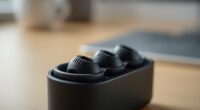Managing high blood pressure at home involves understanding its silent nature, monitoring your levels regularly with proper techniques, and making lifestyle changes like eating a low-salt diet, exercising regularly, and reducing stress. Accurate measurement, being aware of symptoms, and seeking medical advice when needed can help prevent serious health issues. If you want to learn how to effectively control your blood pressure and keep it in check, continue exploring these practical tips.
Key Takeaways
- Regularly monitor blood pressure at home using validated devices and proper technique to detect fluctuations and manage levels effectively.
- Follow lifestyle changes such as reducing salt intake, practicing stress reduction, and engaging in regular physical activity to lower blood pressure.
- Understand that hypertension often has no symptoms but can cause serious health issues; early detection and management are crucial.
- Maintain consistent measurement conditions—sit quietly, support your arm at heart level, and avoid caffeine or exercise beforehand.
- Consult healthcare providers regularly to review readings, adjust treatment plans, and ensure long-term blood pressure control.
What Is High Blood Pressure and Why Does It Matter?

What exactly is high blood pressure, and why should you care about it? It’s a condition where your blood exerts too much force against your artery walls, increasing your risk for serious health issues. Managing it effectively involves medication management, which helps keep your numbers within a safe range. But medication isn’t the only tool—you can also reduce stress to lower your blood pressure naturally. Stress reduction techniques like relaxation exercises, meditation, or deep breathing can make a real difference. Incorporating stress management strategies can further enhance your efforts to control blood pressure. Additionally, understanding the performance metrics of your blood pressure readings can help you and your healthcare provider make more informed decisions. Regular monitoring of your data-driven strategies allows for better tracking of your progress and adjustments to your treatment plan. Recognizing the importance of blood pressure variability can help identify patterns and triggers that affect your readings. Ignoring high blood pressure can lead to heart disease, stroke, or kidney problems. So, understanding what it is and taking proactive steps to control it at home is vital for your long-term health. Staying informed empowers you to make healthier choices every day. Incorporating AI-powered health monitoring devices can also help you track your blood pressure more accurately and manage it effectively.
Recognizing the Symptoms and Risks of Hypertension
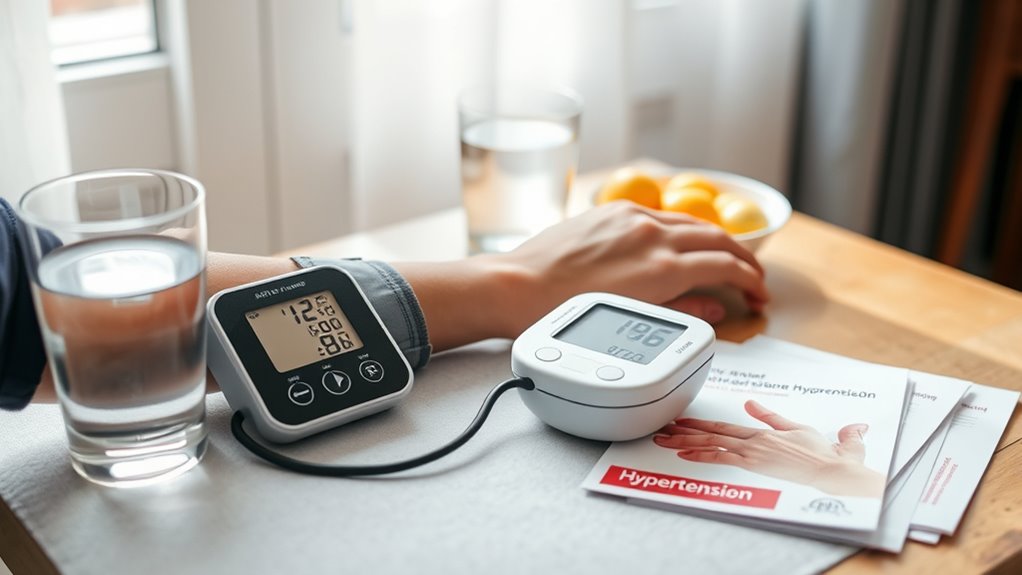
High blood pressure often develops silently, showing few or no obvious symptoms, which is why many people remain unaware they have it. Recognizing the symptoms of hypertension can save your life. Common signs include headaches, dizziness, and blurred vision, but they aren’t always present. The risks of high blood pressure are severe, increasing your chances of heart disease, stroke, and kidney problems. Being aware of these warning signs helps you act early. Here’s a quick overview:
| Symptom of Hypertension | Risk of High Blood Pressure | Warning Signs |
|---|---|---|
| Headaches | Heart attack | Fatigue |
| Dizziness | Stroke | Chest pain |
| Blurred vision | Kidney damage | Shortness of breath |
| Nosebleeds | Eye damage | Irregular heartbeat |
| Fatigue | Aneurysm | Nausea |
Additionally, exfoliation with glycolic acid can improve skin health, and understanding how to incorporate such treatments safely can contribute to overall well-being. Regular monitoring and managing blood pressure levels are essential for reducing long-term health risks.
How to Properly Measure Your Blood Pressure at Home
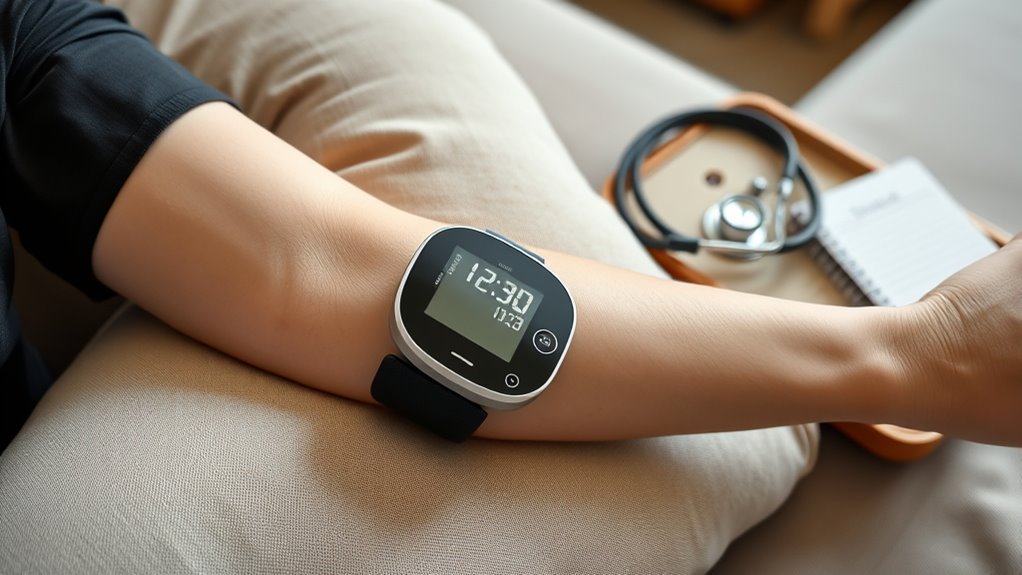
To get accurate readings, you need to follow the correct measurement technique and create ideal conditions. Make certain you’re seated comfortably with your back supported and your arm at heart level. Avoid caffeine, exercise, or smoking 30 minutes before measuring to ensure the most reliable results. Using a validated blood pressure monitor can further improve accuracy. Additionally, maintaining a calm cultural environment can help reduce stress-induced fluctuations in blood pressure readings. Incorporating AI-driven health tools can also assist in tracking and managing your blood pressure more effectively. Remember that wisdom from ancient civilizations can inspire patience and mindfulness during your measurement routine, contributing to more consistent results. Being aware of signs of blood pressure fluctuations can help you better understand your health patterns over time.
Correct Measurement Technique
Ensuring accurate blood pressure readings at home starts with mastering the proper measurement technique. First, pay close attention to cuff positioning; the cuff should be snug but not too tight, with the bottom edge about an inch above your elbow. Proper arm positioning is equally important—rest your arm on a flat surface at heart level, ensuring your back is supported. Keep your legs uncrossed and feet flat on the floor. Sit quietly for five minutes before measuring, avoiding talking or movement during the process. Consistency is key: always use the same arm and follow these steps carefully. Accurate readings depend on correct cuff and arm positioning, so take your time to set up each measurement properly. Additionally, understanding testing methodologies helps ensure that your readings are reliable and consistent over time, especially as device calibration can impact measurement accuracy. Regularly checking your blood pressure with proper technique can also help identify measurement errors early and maintain accurate health monitoring. Being aware of factors affecting accuracy such as body position and environmental conditions can further improve your measurement reliability.
Optimal Measurement Conditions
Have you ever wondered why your blood pressure readings vary from day to day? Proper measurement conditions are vital for accurate results. Sit quietly for five minutes before measuring, and avoid caffeine, exercise, or smoking beforehand. Make sure your cuff is the correct size and placed at heart level, with your feet flat on the floor. Regular device calibration is essential to maintain measurement accuracy; check your monitor’s calibration periodically according to the manufacturer’s instructions. Take two or three readings, a minute apart, and record the results for consistency. Consistent measurement conditions help you track your blood pressure accurately, reducing errors caused by external factors. Additionally, understanding the trustworthiness and vulnerabilities of your blood pressure monitor can help ensure reliable readings. Being aware of the types of cookies and how they are used on health-related websites can assist you in managing your online privacy while researching health data. Recognizing the importance of proper maintenance of your blood pressure monitor can further improve measurement reliability. Selecting a monitor with appropriate validation can enhance the accuracy of your readings. Research indicates that regular cleaning of your device and ensuring filters are in good condition can prevent measurement inaccuracies. By following these tips, you’ll guarantee your readings reflect your true blood pressure, enabling better management of your condition.
Understanding Blood Pressure Readings and What They Mean
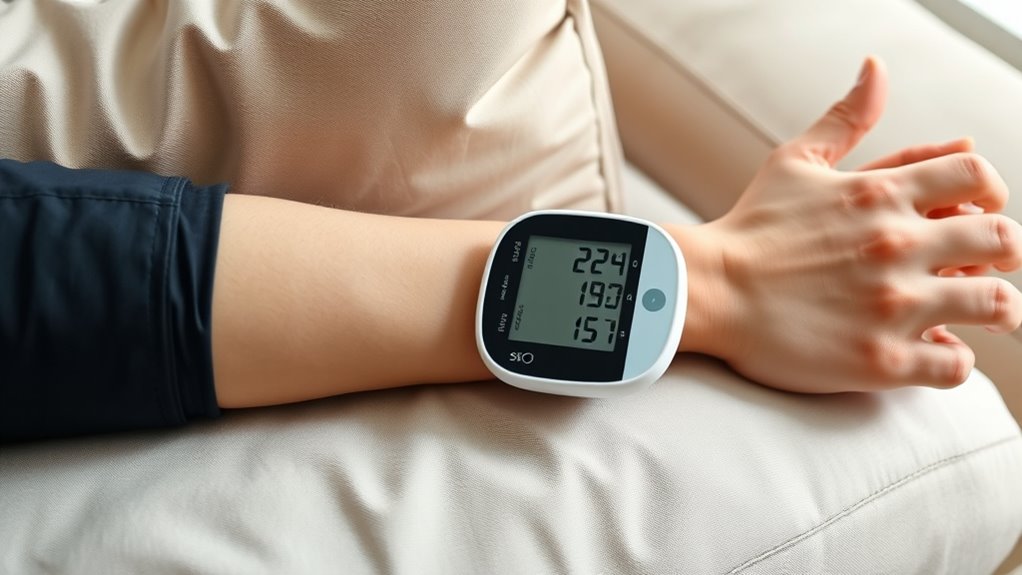
Your blood pressure reading shows two numbers: systolic and diastolic. Understanding what these numbers mean helps you gauge your heart health. Let’s look at how to interpret these values and what they reveal about your blood pressure. Recognizing blood pressure ranges is essential for identifying whether your levels are within a healthy zone or require medical attention. Maintaining proper lifestyle habits, such as adequate sleep and stress management, can positively influence these readings.
Reading Systolic and Diastolic
Understanding blood pressure readings involves knowing what the numbers on your monitor mean. The systolic number measures your heart’s pressure when it beats, while the diastolic reflects pressure between beats. Pay attention to these points:
- Systolic fluctuations can indicate how your heart responds to daily activities or stress.
- Consistent diastolic patterns reveal whether your blood vessels are maintaining steady pressure.
- Variations in either number may signal underlying issues or changes in your blood pressure management.
Interpreting Blood Pressure Numbers
What do those numbers on your blood pressure monitor really mean? The top number, systolic pressure, shows the force your blood exerts when your heart beats, while the bottom number, diastolic pressure, measures pressure between beats. Consistent readings help identify blood pressure variability, which can signal changes in your health. If numbers are too high or fluctuate often, it might indicate the need to review your medication adherence or lifestyle habits. Monitoring regularly allows you to see patterns and work with your healthcare provider to adjust treatments if needed. Remember, even normal readings can be affected by stress, activity, or improper technique. Understanding what these numbers mean empowers you to take control of your blood pressure and stay proactive in managing your health at home.
Lifestyle Changes to Help Reduce Blood Pressure

Making simple lifestyle changes can substantially lower your blood pressure and improve overall health. First, focus on stress reduction techniques like deep breathing or meditation to help keep your blood pressure in check. Second, monitor and reduce your salt intake, as excess salt can cause your body to retain water and increase pressure. Third, incorporate regular physical activity into your routine—exercise strengthens your heart and improves circulation. These changes aren’t just about quick fixes—they promote long-term health and help you manage hypertension effectively. By staying mindful of stress and salt, you take control of your health and reduce the risk of complications. Small, consistent adjustments can make a significant difference in managing your blood pressure at home.
Dietary Tips for Managing Hypertension
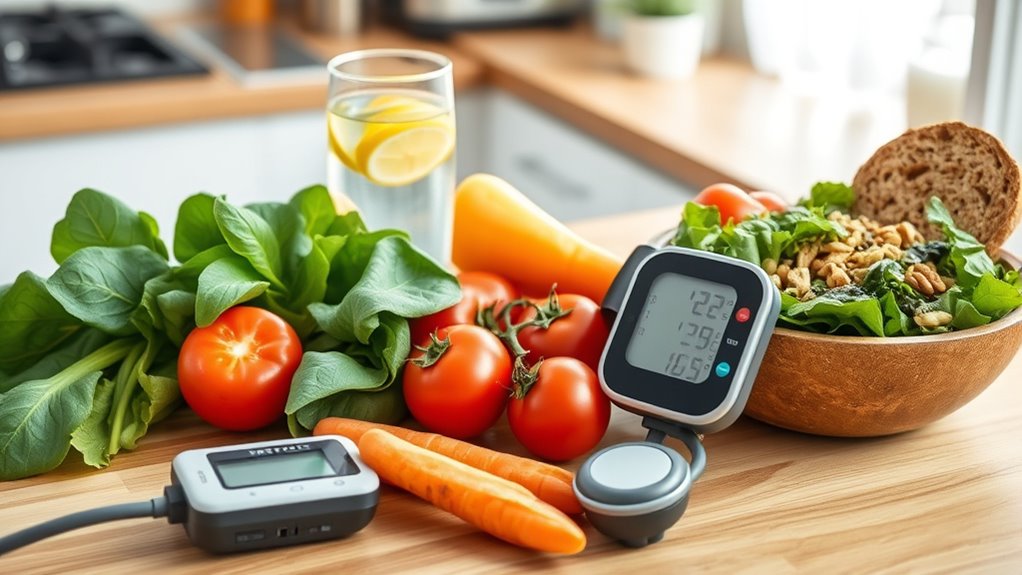
Adopting a heart-healthy diet is a crucial step in managing hypertension effectively. To do this, focus on reducing your sodium intake by avoiding processed foods, fast food, and salty snacks. Instead, flavor your meals with herbs, spices, and lemon. Increasing your potassium intake is equally important, as it helps counteract the effects of sodium and relaxes blood vessel walls. Incorporate potassium-rich foods like bananas, sweet potatoes, spinach, and beans into your diet. Be mindful of portion sizes and aim for a balanced plate that emphasizes fruits, vegetables, whole grains, lean proteins, and healthy fats. These dietary adjustments can markedly lower blood pressure and support overall heart health. Consistency is key; small daily changes add up over time.
Incorporating Exercise and Physical Activity Into Your Routine
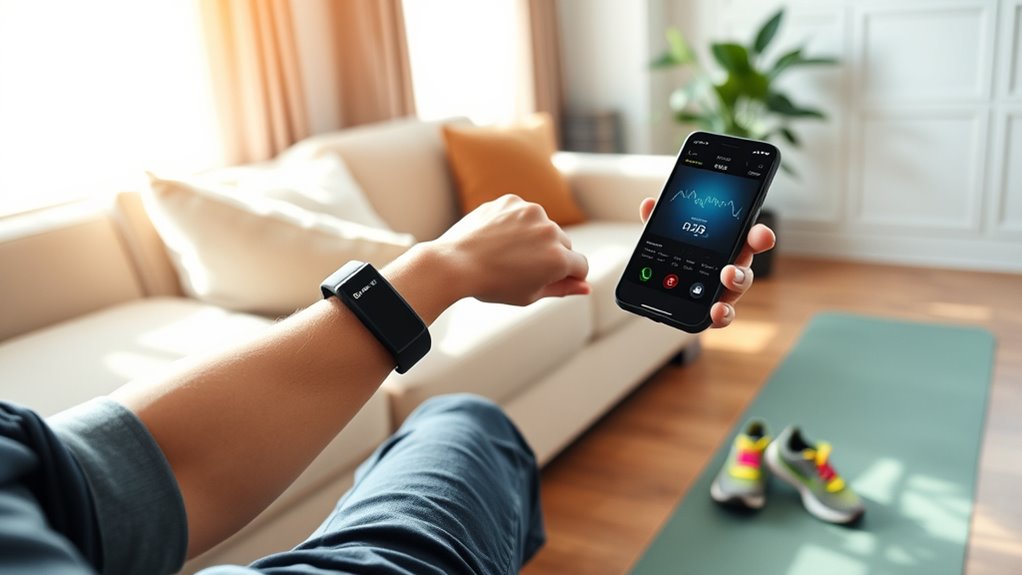
Incorporating regular exercise into your routine is one of the most effective ways to lower blood pressure and improve overall heart health. Engaging in beneficial aerobic activities like brisk walking, cycling, or swimming helps reduce hypertension by strengthening your heart and improving circulation. Strength training, such as weight lifting or resistance exercises, also plays a crucial role by building muscle and supporting vascular health. To maximize benefits, consider these tips:
Regular exercise boosts heart health, lowers blood pressure, and enhances circulation through aerobic and strength activities.
- Aim for at least 150 minutes of moderate aerobic activity weekly.
- Include strength training exercises twice a week.
- Mix different activities to keep your routine engaging and prevent plateaus.
When to Seek Medical Advice and Monitoring Your Progress
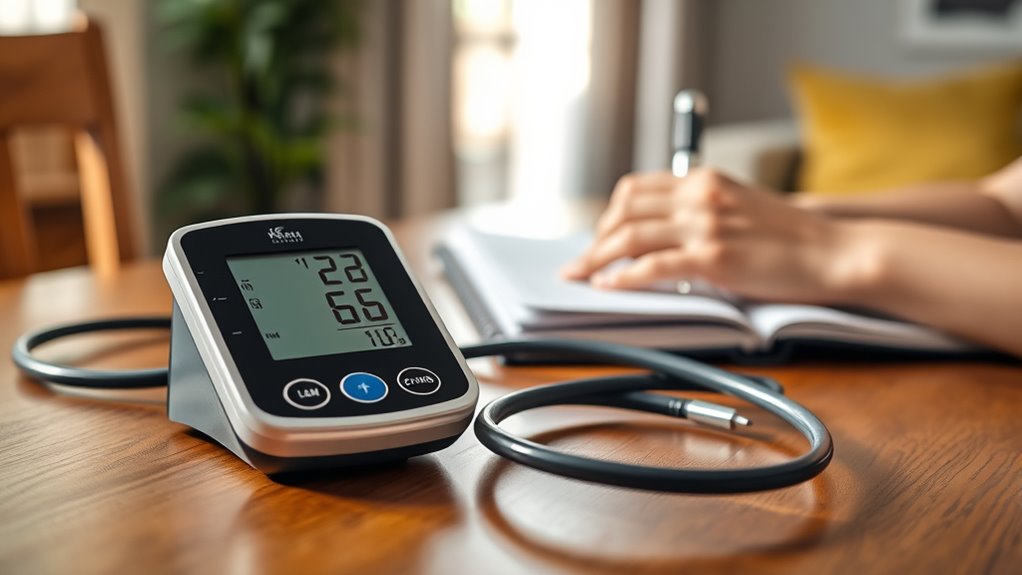
Monitoring your blood pressure regularly and knowing when to seek medical advice are essential steps in managing hypertension effectively. If your readings are consistently high despite lifestyle changes, your doctor may recommend medication adjustments. Watch for emergency symptoms like severe headache, chest pain, shortness of breath, or sudden dizziness—they require immediate medical attention. Regular check-ins help track your progress and catch any concerning trends early. If you experience any unusual symptoms or if your blood pressure remains uncontrolled, don’t hesitate to consult your healthcare provider. Staying vigilant ensures you address potential issues promptly, reducing the risk of complications. Remember, proactive monitoring and timely medical advice are key to maintaining healthy blood pressure levels and safeguarding your health.
Frequently Asked Questions
Can Stress Temporarily Raise My Blood Pressure Readings?
Yes, stress triggers can temporarily raise your blood pressure readings. When you experience stress, your body releases hormones that cause blood vessels to narrow, leading to blood pressure fluctuations. These spikes are usually short-lived, but consistent stress can contribute to ongoing high blood pressure. To get accurate readings, try to relax and avoid stress triggers before measuring your blood pressure. Managing stress effectively helps keep your blood pressure stable.
Are Herbal Supplements Effective for Lowering Blood Pressure?
Think of herbal supplements as tiny ships sailing through your bloodstream—some may help, others might cause storms. While some herbs can lower blood pressure, herbal interactions and supplement safety differ widely. You should always check with your healthcare provider before adding any herbal remedy. They can guide you on effective options and ensure safety, preventing potential adverse effects or harmful interactions that could complicate your health journey.
How Does Sleep Quality Influence Hypertension Management?
Good sleep quality plays a crucial role in managing hypertension. When you practice good sleep hygiene, it helps regulate your circadian rhythm, which controls blood pressure fluctuations throughout the day. Poor sleep can lead to elevated blood pressure and increase your risk of complications. By prioritizing consistent sleep patterns, limiting screens before bed, and creating a relaxing environment, you support better blood pressure control and overall heart health.
What Are the Risks of Over-The-Counter Medications on Blood Pressure?
If you think over-the-counter meds are harmless, think again — they can cause serious risks like dangerous medication interactions and dosage concerns that could skyrocket your blood pressure. Even common remedies might interfere with your hypertension management, making your condition worse. Always check labels and consult your healthcare provider before taking any OTC drugs to avoid unintended complications that could jeopardize your health.
Can High Blood Pressure Be Reversed Without Medication?
Yes, you can often reverse high blood pressure without medication by making lifestyle changes and dietary adjustments. Regular exercise, losing excess weight, reducing salt intake, limiting alcohol, and managing stress can markedly lower your blood pressure. Eating a balanced diet rich in fruits, vegetables, and whole grains also helps. Staying consistent with these habits empowers you to control your blood pressure naturally and reduce reliance on medications.
Conclusion
Managing your blood pressure is like tending a delicate garden—you need consistent care and attention. By understanding your readings and making healthy choices, you nurture your well-being and prevent potential storms. Remember, your commitment is the sunlight that helps this garden flourish. Stay vigilant, monitor regularly, and seek help when needed. With each mindful step, you’re cultivating a healthier, calmer future—your personal sanctuary of peace and strength.


